So what about the .30-30 Winchester as a viable defense round? Is it any good, or should it be hung over the wall with Granddad’s antique snowshoes?
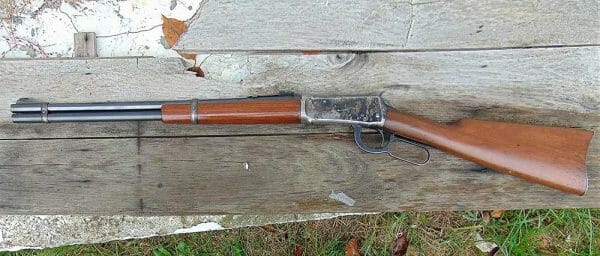
USA – -(AmmoLand.com)- There’s been a lot of talk over the years, in gun shops, around camps and occasionally even in print that the .30-30 Winchester rifle should finally go the way of the Dodo.
I have heard more than one conversation between so-called learned experts that it’s a useless round past the 100-yard mark and that even at that distance, it’s really barely just getting by and that’s just for hunting. So what about the .30-30 as a viable defense round? Is it any good, or should it be hung over the wall with Granddad’s antique snowshoes and left as a memory of another time?
.30-30 Winchester Ammo
Most experts, of course, will throw out there that the best choice for a defensive round would be some semi-auto rifle, and in many cases they would be right, but in some locales, the laws are not always on the side of gun owners, and in some cases, those semi-auto rifles, are restricted or have to be “compliant” which to many of us, translates into another word. Neutered. For instance, in my particular state, any AR platform can’t have a pistol grip with a detachable magazine, which can only be 10 rounds anyway so they have this bizarre stock that resembles PVC pipe or you can have a pistol grip but must load from a stripper clip from the side at an angle. I applaud the gun makers for coming up with alternatives, but these guns are still shadows of their former selves.
Getting back to the .30-30 Winchester, look at the round itself. The 150 grain round is listed at 2,400 fps, and while this isn’t blowing the doors off the competition when you compare it to the .308 or .30-06, you have to be impressed when you compare it to one of the most respected military rounds on the planet, the 7.62x39mm, which with its 123 grain FMJ is also listed at the 2,400 fps mark.
One of the reasons the .30-30 Winchester has always been so popular is because of the gun it was chambered in. Putting the round into the 1894 Winchester rifle and the more desirable carbine with its 20-inch barrel standard gave the shooter a gun that weighed a little more than six pounds and was only thirty-seven inches long. Compare that to say an SKS which weighs over eight pounds and is three inches longer. If the Winchester 94 is not your thing, the Marlin 336 Rifle and it’s predecessors, the 1893, the 1936 and the Model 36 are all fine guns in their own right.
While many tout the .30-30 Winchester’s history of killing game all over this country and even the world, it saw action and military service for decades. In World War I, the US Military bought Winchester 1894 rifles in .30-30 and handed them over to the US Army Signal Corps who were protecting the tree cutting crews in the timber forests in the Pacific Northwest. These crews were cutting spruce which was vital to aircraft production, and these guns have been known afterward as “spruce guns”. There were some eighteen hundred of these carbines issued, with a “US” and flaming bomb ordinance mark on the top of the barrel behind the rear sight.
Closer to the actual battlefield, the British purchased some five thousand 1894 rifles and they were issued to the Royal Navy for use on board their ships, but the French acquired the most, more than fifteen thousand that had sling swivels mounted on the left side of the buttstock and the rear sight had graduations in metric. While not issued to front-line troops, it’s hard not to imagine them seeing some sort of action throughout all that chaos.
Where the .30-30 has been proven and documented, however, has been right here in the US and in the waning days of the Old West.
By the time the 1894 Winchester was introduced, most of the frontier had been settled, the Indian Wars were over, the bison were all but gone from the plains and most of the wild in the wild west had now been tamed. Still, the 1894 Winchester and the .30-30 found favor on both sides of the law and both sides of the border.
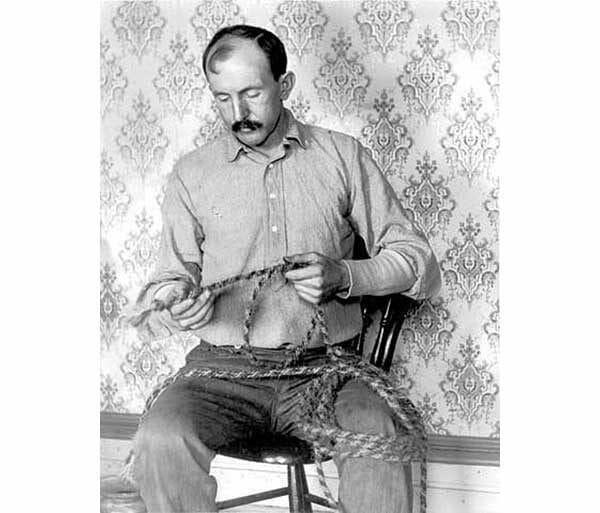
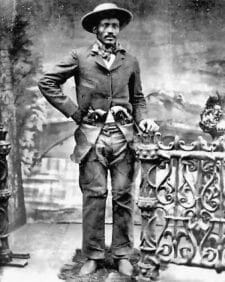
One known and well documented hard case that favored a .30-30 was noted Indian Scout and manhunter, Tom Horn. Horn, who was an interesting character, to say the least, helped bring in Geronimo, hunted down and apprehended men for the Pinkerton Agency before he became a hired killer for the Colorado and Wyoming cattle companies under the guise of the title of “range detective”.
Horn was convicted of shooting and killing fourteen-year-old Willie Nickell and hung for it on November 20, 1903 and while there is still a lot of debate that Horn might not have killed Nickell, there is universal consensus among historians that Horn shot and killed a man named Isom Dart, a cattle thief that had been warned to get out of the area.
On the morning of October 4, 1900, Dart walked out of the front door of his cabin and was struck squarely in his chest, he hit the ground dead. Later two .30-30 shells were found 150-200 yards away from where Dart had been shot.
While many speculated that Horn used a Winchester 1876 in .45-60, and he may have, at the time of the killings he was carrying a Winchester 1894 rifle in .30-30 with a button magazine equipped with a folding tang sight
Horn’s killing of Dart is probably the first known and documented use of a .30-30 for something other than game at long range.

The 1894 Winchester also found favor during the Mexican Revolution, whether in the hands of those fighting for Pancho Villa or the “El Tigre del Sur”, Emiliano Zapata, guns in .30-30 were extremely popular because ammunition was readily available on the American side of the border. During the more than nine years of the revolution rifles and carbines in .30-30 were sought after and used heavily during the whole conflict.
Law enforcement agencies across the country also found the Winchester 1894 in .30-30 to be of value. The New York State Police and the LAPD at one time issued the little carbines to their officers on either coast with many other police departments in between including the Texas Rangers. Arguably the most famous Texas Ranger Joaquin Jackson carried a Winchester 94 in .30-30 that had the barrel cut down to the length of 16 inches, commonly known as a “trapper”. Jackson stated in an interview that he carried that gun at his feet the entire time while working as a Ranger.
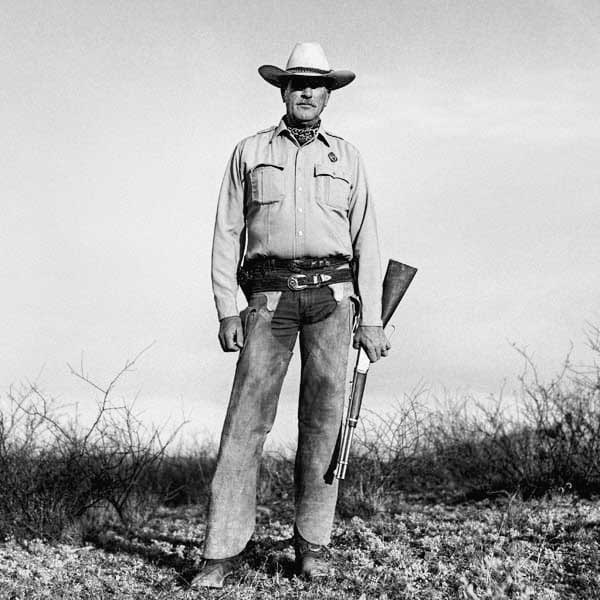
Getting back to the here and now, I decided to see what a good .30-30 could do at some distances some might not consider shooting them, at least not for personal defense. My .30-30 is nothing spectacular, it’s a Winchester 94, known as a “transition” gun, it was made in 1939 and had an earlier style receiver and buttstock of the old saddle ring carbines, which had two factory screw holes in the tang, which allowed for the use of a fold-down sight, but it had a newer style barrel with a ramped front sight. Winchester was essentially using up older parts and in 1940, a new buttstock was used with a flat recoil pad and then the receiver was different slightly with a single hole in the tang and all that was mated to the newer style barrel that was on the transition carbines. My Winchester 94 still has open sights, no peep sights, no scope.
I set up a cut out silhouette target without any aiming points and set it out at 125 yards which was the farthest I could shoot at our little range. I took five of my handloads, a 170 grain Hornady SP with a charge of IMR-4064 that essentially duplicates the factory ballistics. The five shots were all fired from a rest but as quickly as I could get the sights on target and they all hit close with three clustering nearly dead center, and all were pretty much to the point of aim. As you can see, the .30-30 will do just fine out to just past the 100-yard mark, and I would say out to 150 and 175 yards with practice is certainly achievable. Once the .30-30 gets to 200 yards and beyond it begins to lose altitude pretty quickly.
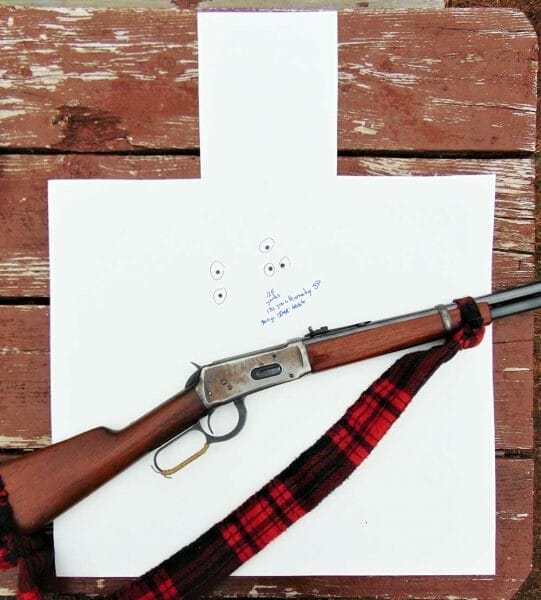
So in this day and age of the war on semi-auto rifles, lever action rifles chambered in .30-30 make a pretty good alternative for personal defense, and since they have a long history of their performance on game, can make a pretty good case for having only one long gun to perform several jobs. Ammunition in .30-30 is literally everywhere and one of the cheaper ones to buy, and handloading for it is simple and easy.
The .30-30 Winchester has been with us for more than 120 years now and it’s been all over the world, and it’s a shame that it seems to have taken a back seat to the belted magnums and wonder rounds that have come along ever since. While it might not be the most powerful round when it comes to knocking down game, it has more than enough for the job of personal defense and it’s almost always found in a lightweight carbine that lends itself to the task. In a compact gun the .30-30 Winchester is at home today at your side as it was in the early squad cars of the LAPD and riding along with those early New York State Troopers. Don’t overlook the .30-30 Winchester in a short carbine like the Model 94 Winchester or Marlin 336, especially in those states were gun owners are stuck behind enemy lines and are not trusted by their own elected officials with any semi-automatic rifles that aren’t neutered or have to be “compliant” in order to even be acceptable.

About David LaPell
David LaPell has been a Corrections Officer with the local Sheriff’s Department for thirteen years. A collector of antique and vintage firearms for over twenty years and an avid hunter. David has been writing articles about firearms, hunting and western history for ten years. In addition to having a passion for vintage guns, he is also a fan of old trucks and has written articles on those as well.
